Auditing: Qantas Airways Analysis
VerifiedAdded on 2019/11/25
|26
|4981
|367
Report
AI Summary
This report provides a detailed analysis of Qantas Airways Limited, focusing on various aspects of business risk assessment. It begins by understanding the nature of the entity through its operations, investments, financing, and financial reporting practices. A thorough industry analysis follows, covering industry size, growth, supply chain, key players, market share, critical success factors, and major threats. The report also examines the legal environment and external environmental factors using PESTLE analysis, Porter's Five Forces, and SWOT analysis. A key section assesses business risks related to industry developments, new products and services, business expansion, accounting requirements, regulatory requirements, financing prospects, IT usage, and strategic impact. The report then performs analytical procedures to understand the entity's performance using profitability, liquidity, leverage, and operating margin ratios, comparing Qantas to its competitor, Virgin Australia. Finally, it examines Qantas' management and governance, including ethical values, competence, governance participation, management philosophy, organizational structure, authority allocation, and HR practices. The conclusion highlights Qantas' leadership in the Australian aviation industry and its successful performance.
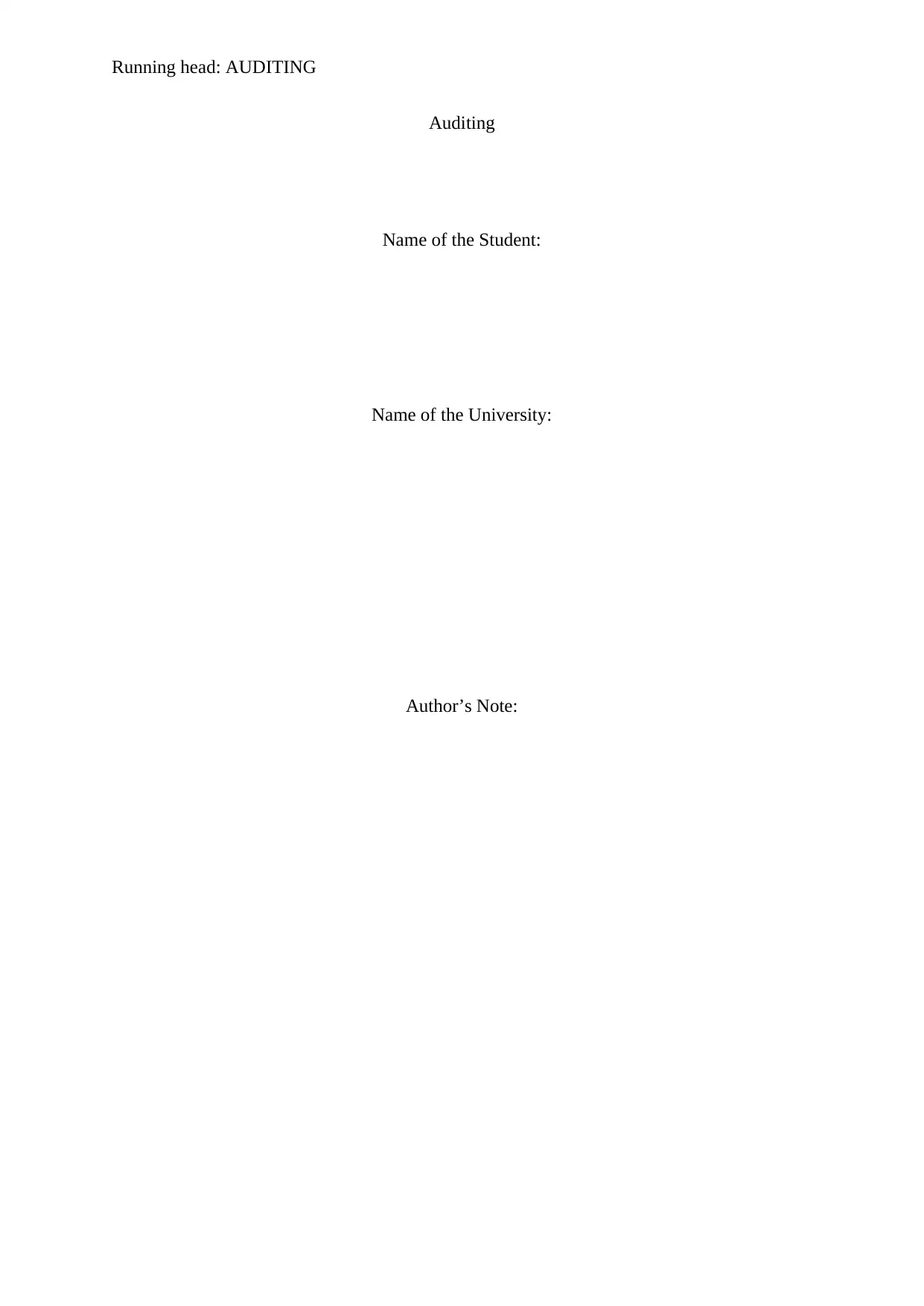
Running head: AUDITING
Auditing
Name of the Student:
Name of the University:
Author’s Note:
Auditing
Name of the Student:
Name of the University:
Author’s Note:
Paraphrase This Document
Need a fresh take? Get an instant paraphrase of this document with our AI Paraphraser
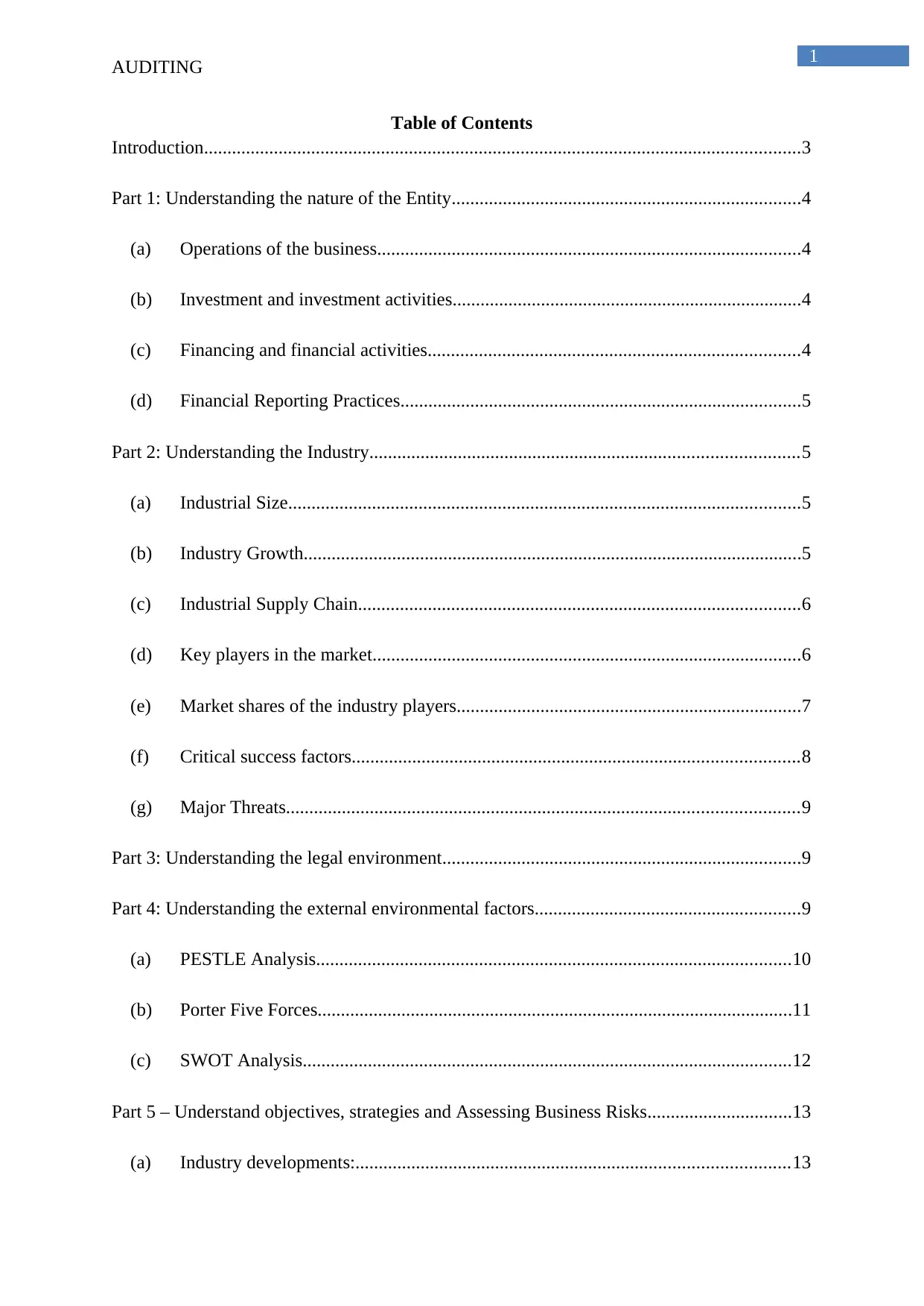
1
AUDITING
Table of Contents
Introduction................................................................................................................................3
Part 1: Understanding the nature of the Entity...........................................................................4
(a) Operations of the business...........................................................................................4
(b) Investment and investment activities...........................................................................4
(c) Financing and financial activities................................................................................4
(d) Financial Reporting Practices......................................................................................5
Part 2: Understanding the Industry............................................................................................5
(a) Industrial Size..............................................................................................................5
(b) Industry Growth...........................................................................................................5
(c) Industrial Supply Chain...............................................................................................6
(d) Key players in the market............................................................................................6
(e) Market shares of the industry players..........................................................................7
(f) Critical success factors................................................................................................8
(g) Major Threats..............................................................................................................9
Part 3: Understanding the legal environment.............................................................................9
Part 4: Understanding the external environmental factors.........................................................9
(a) PESTLE Analysis......................................................................................................10
(b) Porter Five Forces......................................................................................................11
(c) SWOT Analysis.........................................................................................................12
Part 5 – Understand objectives, strategies and Assessing Business Risks...............................13
(a) Industry developments:.............................................................................................13
AUDITING
Table of Contents
Introduction................................................................................................................................3
Part 1: Understanding the nature of the Entity...........................................................................4
(a) Operations of the business...........................................................................................4
(b) Investment and investment activities...........................................................................4
(c) Financing and financial activities................................................................................4
(d) Financial Reporting Practices......................................................................................5
Part 2: Understanding the Industry............................................................................................5
(a) Industrial Size..............................................................................................................5
(b) Industry Growth...........................................................................................................5
(c) Industrial Supply Chain...............................................................................................6
(d) Key players in the market............................................................................................6
(e) Market shares of the industry players..........................................................................7
(f) Critical success factors................................................................................................8
(g) Major Threats..............................................................................................................9
Part 3: Understanding the legal environment.............................................................................9
Part 4: Understanding the external environmental factors.........................................................9
(a) PESTLE Analysis......................................................................................................10
(b) Porter Five Forces......................................................................................................11
(c) SWOT Analysis.........................................................................................................12
Part 5 – Understand objectives, strategies and Assessing Business Risks...............................13
(a) Industry developments:.............................................................................................13
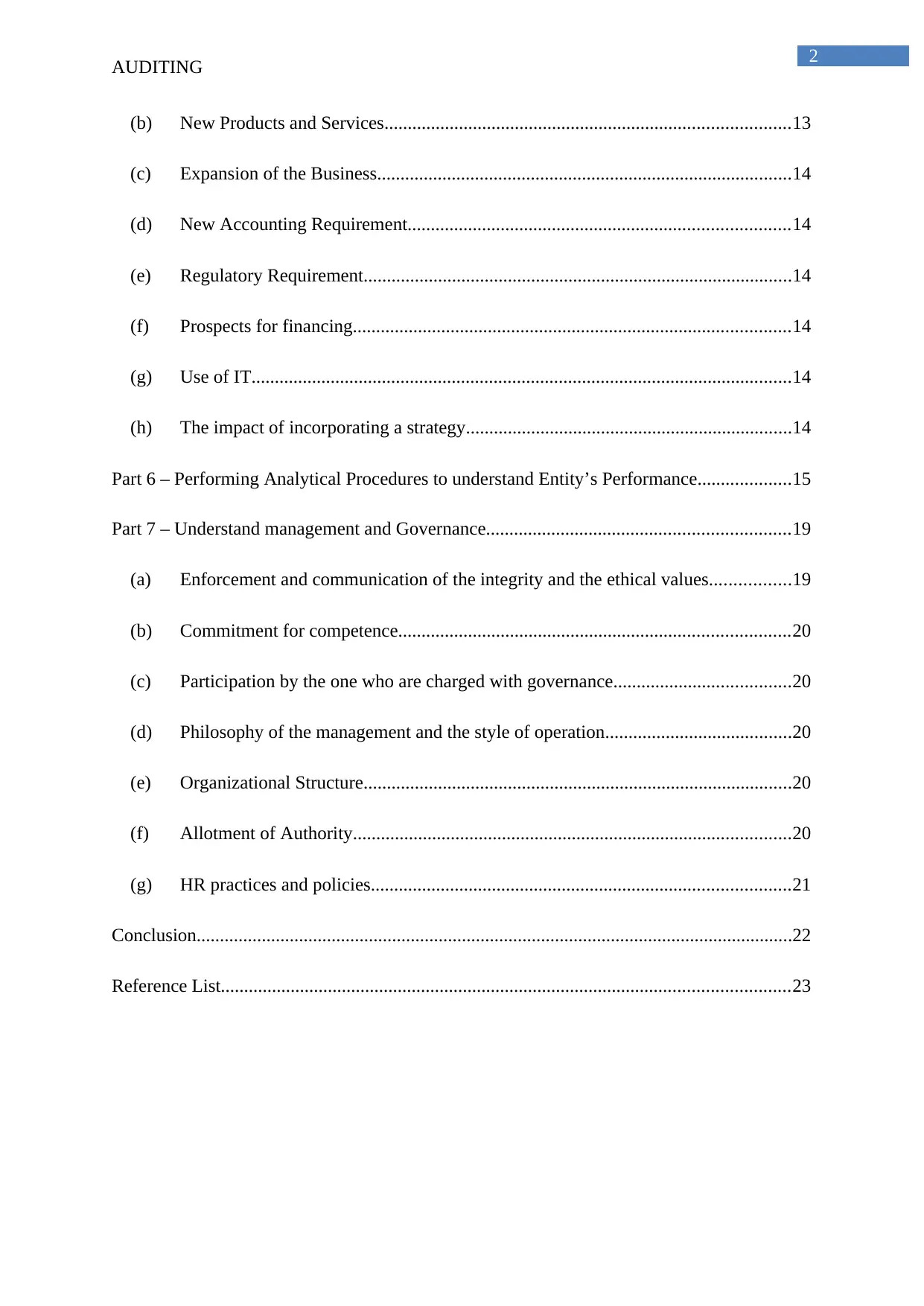
2
AUDITING
(b) New Products and Services.......................................................................................13
(c) Expansion of the Business.........................................................................................14
(d) New Accounting Requirement..................................................................................14
(e) Regulatory Requirement............................................................................................14
(f) Prospects for financing..............................................................................................14
(g) Use of IT....................................................................................................................14
(h) The impact of incorporating a strategy......................................................................14
Part 6 – Performing Analytical Procedures to understand Entity’s Performance....................15
Part 7 – Understand management and Governance.................................................................19
(a) Enforcement and communication of the integrity and the ethical values.................19
(b) Commitment for competence....................................................................................20
(c) Participation by the one who are charged with governance......................................20
(d) Philosophy of the management and the style of operation........................................20
(e) Organizational Structure............................................................................................20
(f) Allotment of Authority..............................................................................................20
(g) HR practices and policies..........................................................................................21
Conclusion................................................................................................................................22
Reference List..........................................................................................................................23
AUDITING
(b) New Products and Services.......................................................................................13
(c) Expansion of the Business.........................................................................................14
(d) New Accounting Requirement..................................................................................14
(e) Regulatory Requirement............................................................................................14
(f) Prospects for financing..............................................................................................14
(g) Use of IT....................................................................................................................14
(h) The impact of incorporating a strategy......................................................................14
Part 6 – Performing Analytical Procedures to understand Entity’s Performance....................15
Part 7 – Understand management and Governance.................................................................19
(a) Enforcement and communication of the integrity and the ethical values.................19
(b) Commitment for competence....................................................................................20
(c) Participation by the one who are charged with governance......................................20
(d) Philosophy of the management and the style of operation........................................20
(e) Organizational Structure............................................................................................20
(f) Allotment of Authority..............................................................................................20
(g) HR practices and policies..........................................................................................21
Conclusion................................................................................................................................22
Reference List..........................................................................................................................23
⊘ This is a preview!⊘
Do you want full access?
Subscribe today to unlock all pages.

Trusted by 1+ million students worldwide

3
AUDITING
Introduction
This paper has been constructed in order to focus on the numerous aspects of the
analysis of the business risk that is associated with Qantas Airways Limited. There have been
few crucial components in regards to this research paper that have been observed in
accordance to the utilisation of numerous kinds of the entities that have been observed while
gaining knowledge about the Industry Regulatory and External Factors. There are certain
other components in regards to this report that have been revealed the governance of the
management structure and the characteristic of the entity (Chen and Liu 2017). The paper has
moreover explained the various kinds if the components for the risks that are related to the
business and even the objectives and the strategies utilised by the organizations.
The different kinds of ways of gaining knowledge about the originations have been
undertaken with the utilisation of the operations of the business, investment operations and
the practices of the financial reports. The next segment of the paper has explained about the
industrial development or growth, chain of the industry supply, the problems related ti the
significant factors of success and the share of market of the key industrial companies. The
third segment of the paper has additionally observed to explain on the understanding of the
legal atmosphere. The various kinds of the other components of the paper that have been
observed with the knowledge about the factors related to the extrinsic factors, structure of the
corporate governance and the management associated with the organizations (Xu and Cui
2017). The primary focus of this paper has been additionally observed to be given on the
completion of the analytical process for gaining knowledge about the entity. The last section
of the paper has revealed a crucial amount of the concentration, which has been noticed to be
associated to the knowledge of the structure of the company, operating and the philosophical
style associated to it.
AUDITING
Introduction
This paper has been constructed in order to focus on the numerous aspects of the
analysis of the business risk that is associated with Qantas Airways Limited. There have been
few crucial components in regards to this research paper that have been observed in
accordance to the utilisation of numerous kinds of the entities that have been observed while
gaining knowledge about the Industry Regulatory and External Factors. There are certain
other components in regards to this report that have been revealed the governance of the
management structure and the characteristic of the entity (Chen and Liu 2017). The paper has
moreover explained the various kinds if the components for the risks that are related to the
business and even the objectives and the strategies utilised by the organizations.
The different kinds of ways of gaining knowledge about the originations have been
undertaken with the utilisation of the operations of the business, investment operations and
the practices of the financial reports. The next segment of the paper has explained about the
industrial development or growth, chain of the industry supply, the problems related ti the
significant factors of success and the share of market of the key industrial companies. The
third segment of the paper has additionally observed to explain on the understanding of the
legal atmosphere. The various kinds of the other components of the paper that have been
observed with the knowledge about the factors related to the extrinsic factors, structure of the
corporate governance and the management associated with the organizations (Xu and Cui
2017). The primary focus of this paper has been additionally observed to be given on the
completion of the analytical process for gaining knowledge about the entity. The last section
of the paper has revealed a crucial amount of the concentration, which has been noticed to be
associated to the knowledge of the structure of the company, operating and the philosophical
style associated to it.
Paraphrase This Document
Need a fresh take? Get an instant paraphrase of this document with our AI Paraphraser
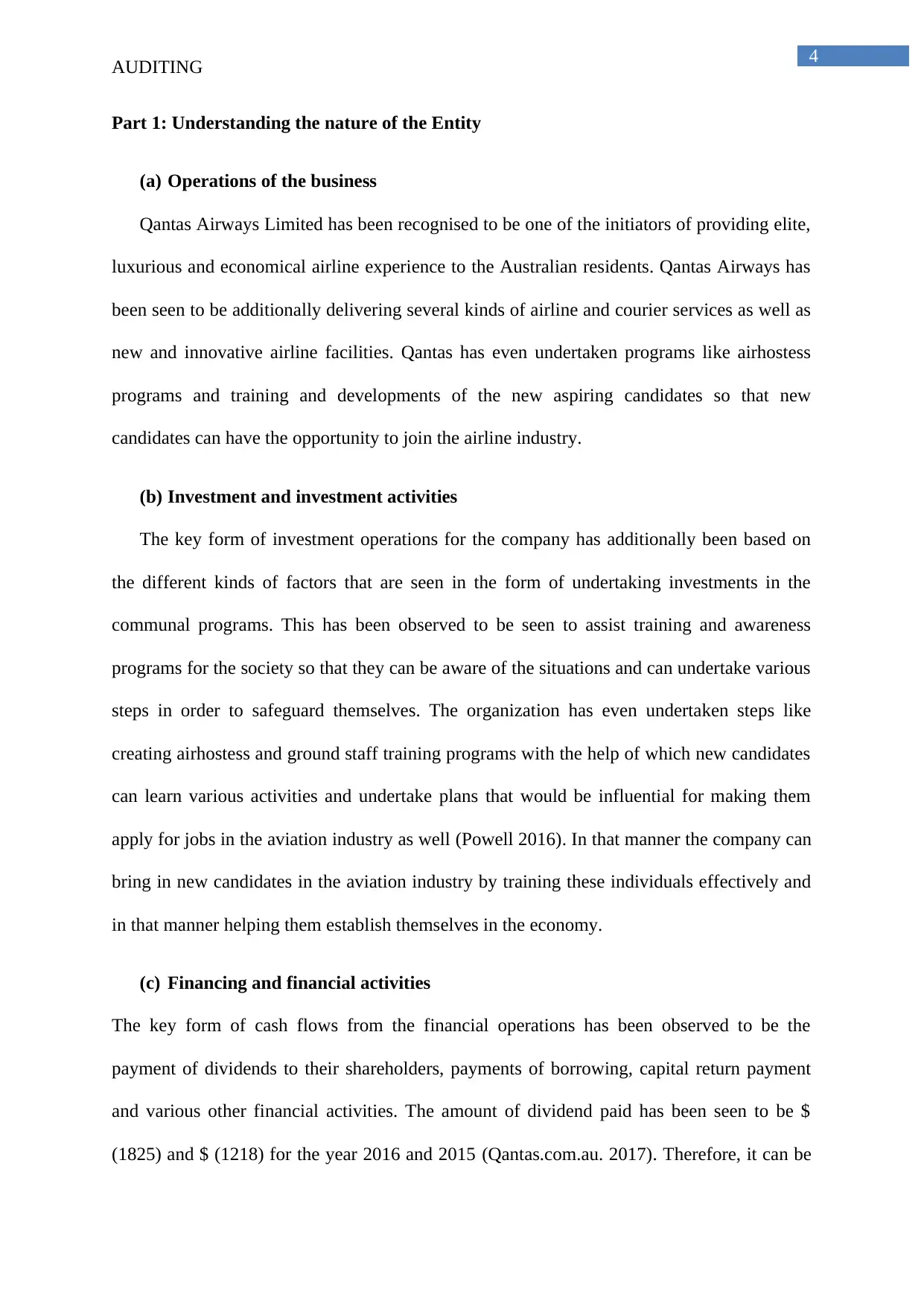
4
AUDITING
Part 1: Understanding the nature of the Entity
(a) Operations of the business
Qantas Airways Limited has been recognised to be one of the initiators of providing elite,
luxurious and economical airline experience to the Australian residents. Qantas Airways has
been seen to be additionally delivering several kinds of airline and courier services as well as
new and innovative airline facilities. Qantas has even undertaken programs like airhostess
programs and training and developments of the new aspiring candidates so that new
candidates can have the opportunity to join the airline industry.
(b) Investment and investment activities
The key form of investment operations for the company has additionally been based on
the different kinds of factors that are seen in the form of undertaking investments in the
communal programs. This has been observed to be seen to assist training and awareness
programs for the society so that they can be aware of the situations and can undertake various
steps in order to safeguard themselves. The organization has even undertaken steps like
creating airhostess and ground staff training programs with the help of which new candidates
can learn various activities and undertake plans that would be influential for making them
apply for jobs in the aviation industry as well (Powell 2016). In that manner the company can
bring in new candidates in the aviation industry by training these individuals effectively and
in that manner helping them establish themselves in the economy.
(c) Financing and financial activities
The key form of cash flows from the financial operations has been observed to be the
payment of dividends to their shareholders, payments of borrowing, capital return payment
and various other financial activities. The amount of dividend paid has been seen to be $
(1825) and $ (1218) for the year 2016 and 2015 (Qantas.com.au. 2017). Therefore, it can be
AUDITING
Part 1: Understanding the nature of the Entity
(a) Operations of the business
Qantas Airways Limited has been recognised to be one of the initiators of providing elite,
luxurious and economical airline experience to the Australian residents. Qantas Airways has
been seen to be additionally delivering several kinds of airline and courier services as well as
new and innovative airline facilities. Qantas has even undertaken programs like airhostess
programs and training and developments of the new aspiring candidates so that new
candidates can have the opportunity to join the airline industry.
(b) Investment and investment activities
The key form of investment operations for the company has additionally been based on
the different kinds of factors that are seen in the form of undertaking investments in the
communal programs. This has been observed to be seen to assist training and awareness
programs for the society so that they can be aware of the situations and can undertake various
steps in order to safeguard themselves. The organization has even undertaken steps like
creating airhostess and ground staff training programs with the help of which new candidates
can learn various activities and undertake plans that would be influential for making them
apply for jobs in the aviation industry as well (Powell 2016). In that manner the company can
bring in new candidates in the aviation industry by training these individuals effectively and
in that manner helping them establish themselves in the economy.
(c) Financing and financial activities
The key form of cash flows from the financial operations has been observed to be the
payment of dividends to their shareholders, payments of borrowing, capital return payment
and various other financial activities. The amount of dividend paid has been seen to be $
(1825) and $ (1218) for the year 2016 and 2015 (Qantas.com.au. 2017). Therefore, it can be
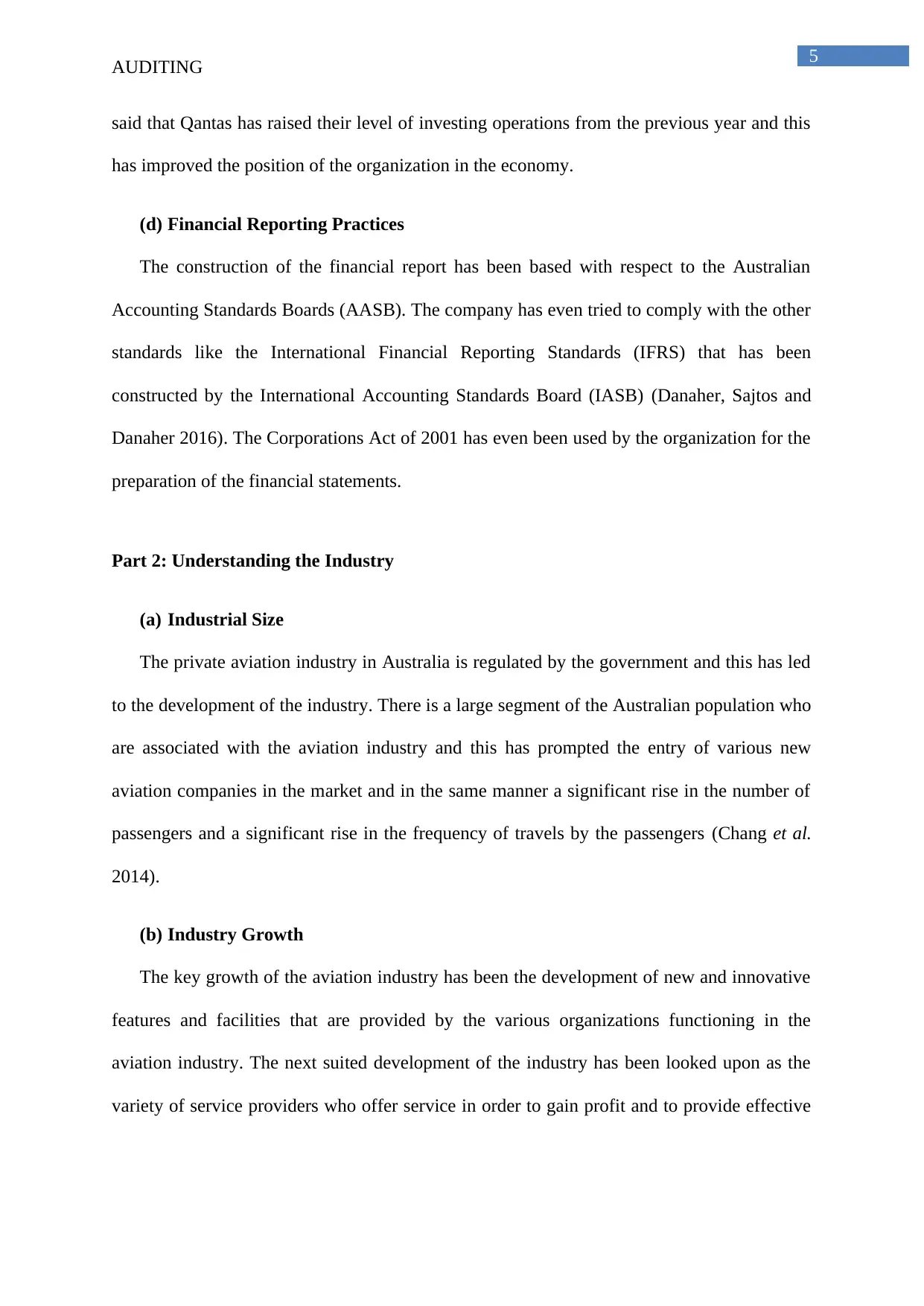
5
AUDITING
said that Qantas has raised their level of investing operations from the previous year and this
has improved the position of the organization in the economy.
(d) Financial Reporting Practices
The construction of the financial report has been based with respect to the Australian
Accounting Standards Boards (AASB). The company has even tried to comply with the other
standards like the International Financial Reporting Standards (IFRS) that has been
constructed by the International Accounting Standards Board (IASB) (Danaher, Sajtos and
Danaher 2016). The Corporations Act of 2001 has even been used by the organization for the
preparation of the financial statements.
Part 2: Understanding the Industry
(a) Industrial Size
The private aviation industry in Australia is regulated by the government and this has led
to the development of the industry. There is a large segment of the Australian population who
are associated with the aviation industry and this has prompted the entry of various new
aviation companies in the market and in the same manner a significant rise in the number of
passengers and a significant rise in the frequency of travels by the passengers (Chang et al.
2014).
(b) Industry Growth
The key growth of the aviation industry has been the development of new and innovative
features and facilities that are provided by the various organizations functioning in the
aviation industry. The next suited development of the industry has been looked upon as the
variety of service providers who offer service in order to gain profit and to provide effective
AUDITING
said that Qantas has raised their level of investing operations from the previous year and this
has improved the position of the organization in the economy.
(d) Financial Reporting Practices
The construction of the financial report has been based with respect to the Australian
Accounting Standards Boards (AASB). The company has even tried to comply with the other
standards like the International Financial Reporting Standards (IFRS) that has been
constructed by the International Accounting Standards Board (IASB) (Danaher, Sajtos and
Danaher 2016). The Corporations Act of 2001 has even been used by the organization for the
preparation of the financial statements.
Part 2: Understanding the Industry
(a) Industrial Size
The private aviation industry in Australia is regulated by the government and this has led
to the development of the industry. There is a large segment of the Australian population who
are associated with the aviation industry and this has prompted the entry of various new
aviation companies in the market and in the same manner a significant rise in the number of
passengers and a significant rise in the frequency of travels by the passengers (Chang et al.
2014).
(b) Industry Growth
The key growth of the aviation industry has been the development of new and innovative
features and facilities that are provided by the various organizations functioning in the
aviation industry. The next suited development of the industry has been looked upon as the
variety of service providers who offer service in order to gain profit and to provide effective
⊘ This is a preview!⊘
Do you want full access?
Subscribe today to unlock all pages.

Trusted by 1+ million students worldwide
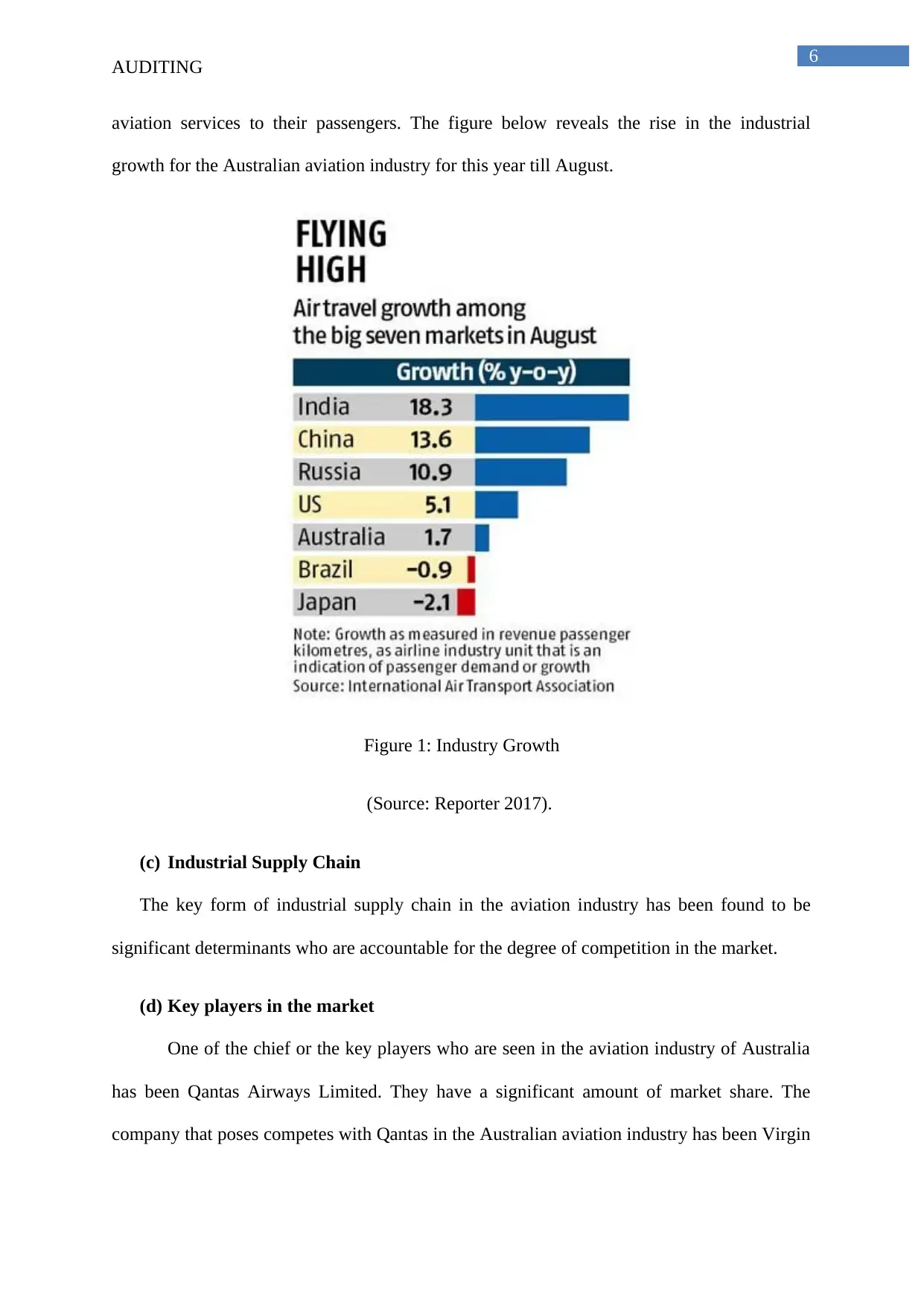
6
AUDITING
aviation services to their passengers. The figure below reveals the rise in the industrial
growth for the Australian aviation industry for this year till August.
Figure 1: Industry Growth
(Source: Reporter 2017).
(c) Industrial Supply Chain
The key form of industrial supply chain in the aviation industry has been found to be
significant determinants who are accountable for the degree of competition in the market.
(d) Key players in the market
One of the chief or the key players who are seen in the aviation industry of Australia
has been Qantas Airways Limited. They have a significant amount of market share. The
company that poses competes with Qantas in the Australian aviation industry has been Virgin
AUDITING
aviation services to their passengers. The figure below reveals the rise in the industrial
growth for the Australian aviation industry for this year till August.
Figure 1: Industry Growth
(Source: Reporter 2017).
(c) Industrial Supply Chain
The key form of industrial supply chain in the aviation industry has been found to be
significant determinants who are accountable for the degree of competition in the market.
(d) Key players in the market
One of the chief or the key players who are seen in the aviation industry of Australia
has been Qantas Airways Limited. They have a significant amount of market share. The
company that poses competes with Qantas in the Australian aviation industry has been Virgin
Paraphrase This Document
Need a fresh take? Get an instant paraphrase of this document with our AI Paraphraser
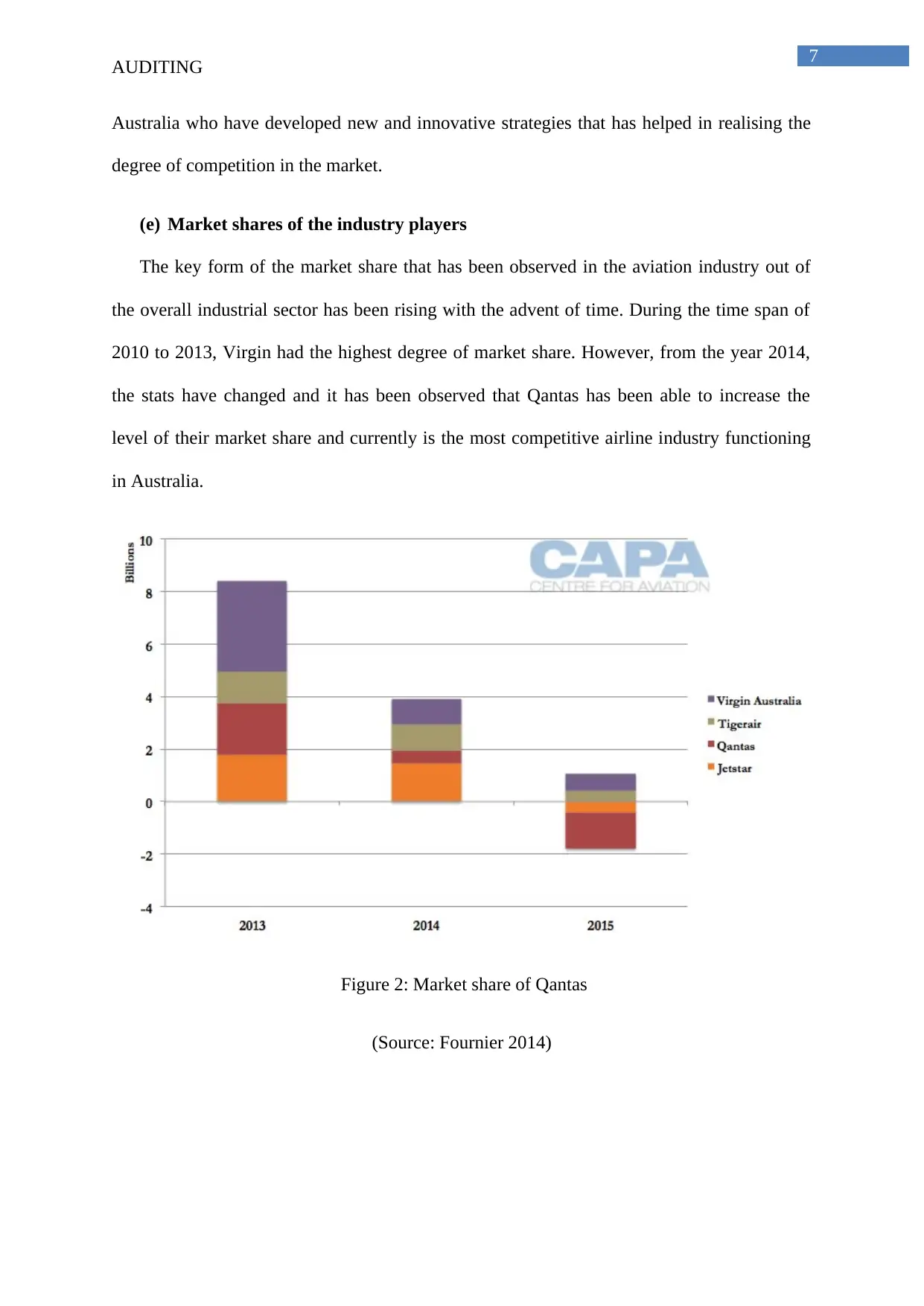
7
AUDITING
Australia who have developed new and innovative strategies that has helped in realising the
degree of competition in the market.
(e) Market shares of the industry players
The key form of the market share that has been observed in the aviation industry out of
the overall industrial sector has been rising with the advent of time. During the time span of
2010 to 2013, Virgin had the highest degree of market share. However, from the year 2014,
the stats have changed and it has been observed that Qantas has been able to increase the
level of their market share and currently is the most competitive airline industry functioning
in Australia.
Figure 2: Market share of Qantas
(Source: Fournier 2014)
AUDITING
Australia who have developed new and innovative strategies that has helped in realising the
degree of competition in the market.
(e) Market shares of the industry players
The key form of the market share that has been observed in the aviation industry out of
the overall industrial sector has been rising with the advent of time. During the time span of
2010 to 2013, Virgin had the highest degree of market share. However, from the year 2014,
the stats have changed and it has been observed that Qantas has been able to increase the
level of their market share and currently is the most competitive airline industry functioning
in Australia.
Figure 2: Market share of Qantas
(Source: Fournier 2014)
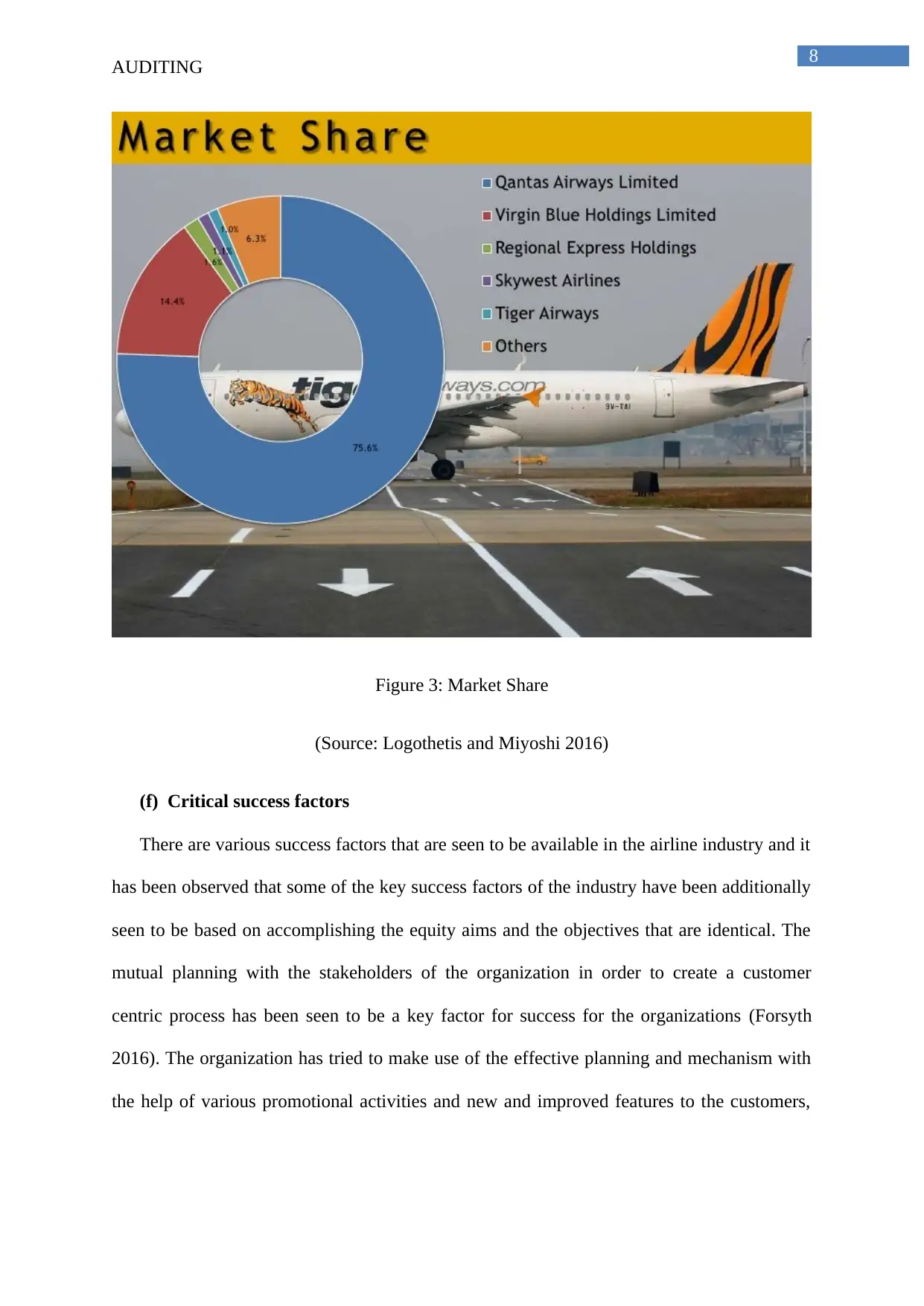
8
AUDITING
Figure 3: Market Share
(Source: Logothetis and Miyoshi 2016)
(f) Critical success factors
There are various success factors that are seen to be available in the airline industry and it
has been observed that some of the key success factors of the industry have been additionally
seen to be based on accomplishing the equity aims and the objectives that are identical. The
mutual planning with the stakeholders of the organization in order to create a customer
centric process has been seen to be a key factor for success for the organizations (Forsyth
2016). The organization has tried to make use of the effective planning and mechanism with
the help of various promotional activities and new and improved features to the customers,
AUDITING
Figure 3: Market Share
(Source: Logothetis and Miyoshi 2016)
(f) Critical success factors
There are various success factors that are seen to be available in the airline industry and it
has been observed that some of the key success factors of the industry have been additionally
seen to be based on accomplishing the equity aims and the objectives that are identical. The
mutual planning with the stakeholders of the organization in order to create a customer
centric process has been seen to be a key factor for success for the organizations (Forsyth
2016). The organization has tried to make use of the effective planning and mechanism with
the help of various promotional activities and new and improved features to the customers,
⊘ This is a preview!⊘
Do you want full access?
Subscribe today to unlock all pages.

Trusted by 1+ million students worldwide
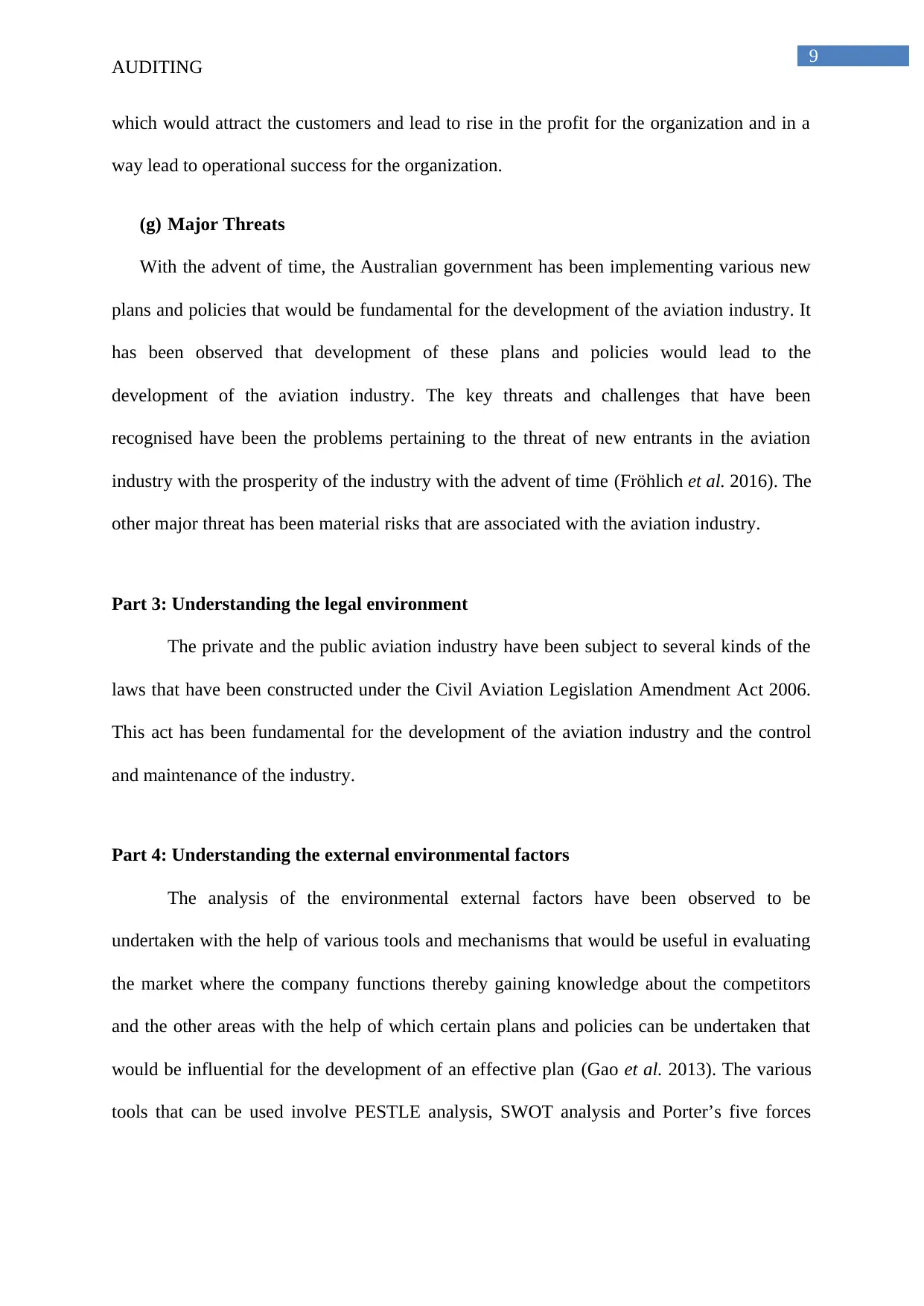
9
AUDITING
which would attract the customers and lead to rise in the profit for the organization and in a
way lead to operational success for the organization.
(g) Major Threats
With the advent of time, the Australian government has been implementing various new
plans and policies that would be fundamental for the development of the aviation industry. It
has been observed that development of these plans and policies would lead to the
development of the aviation industry. The key threats and challenges that have been
recognised have been the problems pertaining to the threat of new entrants in the aviation
industry with the prosperity of the industry with the advent of time (Fröhlich et al. 2016). The
other major threat has been material risks that are associated with the aviation industry.
Part 3: Understanding the legal environment
The private and the public aviation industry have been subject to several kinds of the
laws that have been constructed under the Civil Aviation Legislation Amendment Act 2006.
This act has been fundamental for the development of the aviation industry and the control
and maintenance of the industry.
Part 4: Understanding the external environmental factors
The analysis of the environmental external factors have been observed to be
undertaken with the help of various tools and mechanisms that would be useful in evaluating
the market where the company functions thereby gaining knowledge about the competitors
and the other areas with the help of which certain plans and policies can be undertaken that
would be influential for the development of an effective plan (Gao et al. 2013). The various
tools that can be used involve PESTLE analysis, SWOT analysis and Porter’s five forces
AUDITING
which would attract the customers and lead to rise in the profit for the organization and in a
way lead to operational success for the organization.
(g) Major Threats
With the advent of time, the Australian government has been implementing various new
plans and policies that would be fundamental for the development of the aviation industry. It
has been observed that development of these plans and policies would lead to the
development of the aviation industry. The key threats and challenges that have been
recognised have been the problems pertaining to the threat of new entrants in the aviation
industry with the prosperity of the industry with the advent of time (Fröhlich et al. 2016). The
other major threat has been material risks that are associated with the aviation industry.
Part 3: Understanding the legal environment
The private and the public aviation industry have been subject to several kinds of the
laws that have been constructed under the Civil Aviation Legislation Amendment Act 2006.
This act has been fundamental for the development of the aviation industry and the control
and maintenance of the industry.
Part 4: Understanding the external environmental factors
The analysis of the environmental external factors have been observed to be
undertaken with the help of various tools and mechanisms that would be useful in evaluating
the market where the company functions thereby gaining knowledge about the competitors
and the other areas with the help of which certain plans and policies can be undertaken that
would be influential for the development of an effective plan (Gao et al. 2013). The various
tools that can be used involve PESTLE analysis, SWOT analysis and Porter’s five forces
Paraphrase This Document
Need a fresh take? Get an instant paraphrase of this document with our AI Paraphraser
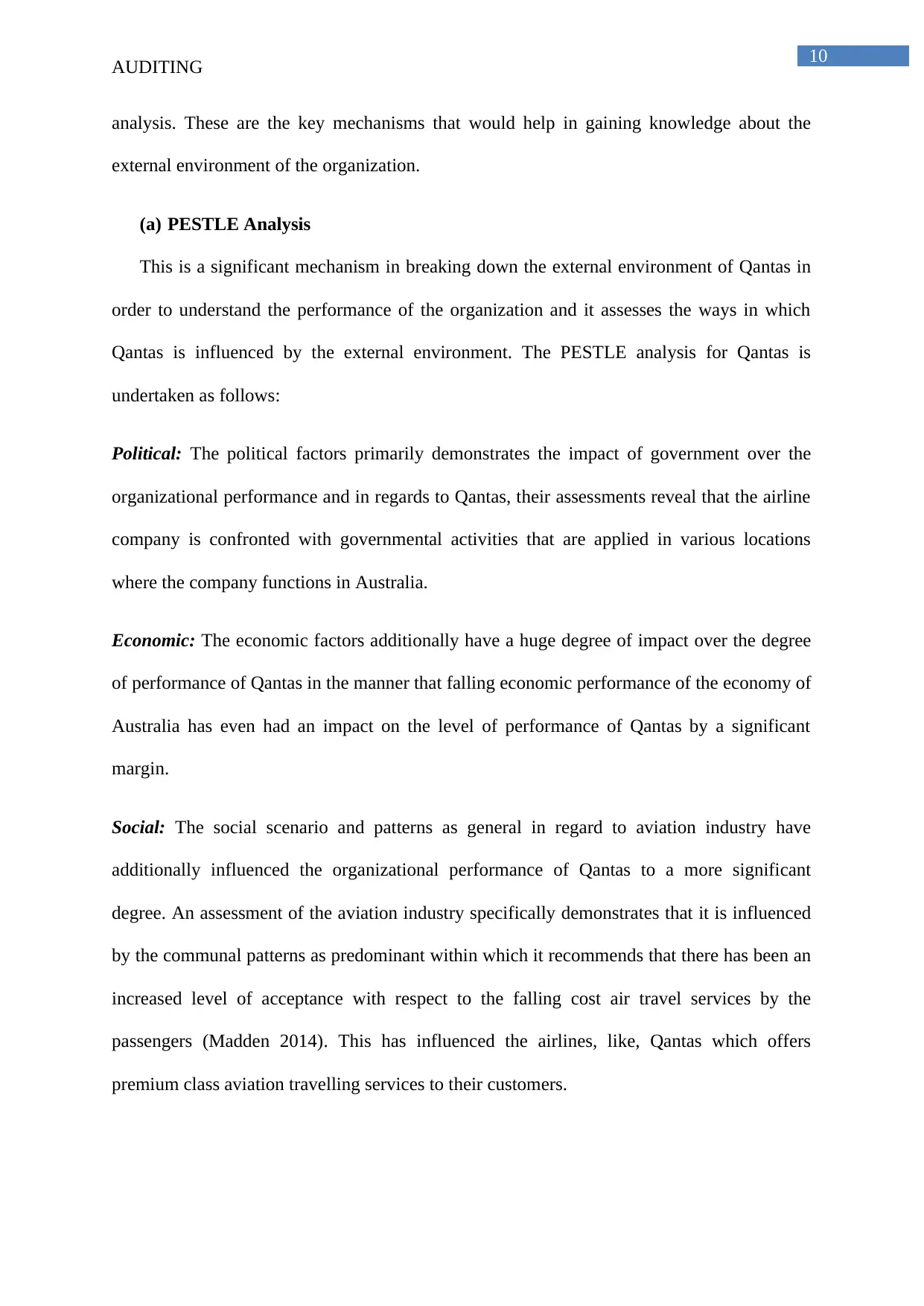
10
AUDITING
analysis. These are the key mechanisms that would help in gaining knowledge about the
external environment of the organization.
(a) PESTLE Analysis
This is a significant mechanism in breaking down the external environment of Qantas in
order to understand the performance of the organization and it assesses the ways in which
Qantas is influenced by the external environment. The PESTLE analysis for Qantas is
undertaken as follows:
Political: The political factors primarily demonstrates the impact of government over the
organizational performance and in regards to Qantas, their assessments reveal that the airline
company is confronted with governmental activities that are applied in various locations
where the company functions in Australia.
Economic: The economic factors additionally have a huge degree of impact over the degree
of performance of Qantas in the manner that falling economic performance of the economy of
Australia has even had an impact on the level of performance of Qantas by a significant
margin.
Social: The social scenario and patterns as general in regard to aviation industry have
additionally influenced the organizational performance of Qantas to a more significant
degree. An assessment of the aviation industry specifically demonstrates that it is influenced
by the communal patterns as predominant within which it recommends that there has been an
increased level of acceptance with respect to the falling cost air travel services by the
passengers (Madden 2014). This has influenced the airlines, like, Qantas which offers
premium class aviation travelling services to their customers.
AUDITING
analysis. These are the key mechanisms that would help in gaining knowledge about the
external environment of the organization.
(a) PESTLE Analysis
This is a significant mechanism in breaking down the external environment of Qantas in
order to understand the performance of the organization and it assesses the ways in which
Qantas is influenced by the external environment. The PESTLE analysis for Qantas is
undertaken as follows:
Political: The political factors primarily demonstrates the impact of government over the
organizational performance and in regards to Qantas, their assessments reveal that the airline
company is confronted with governmental activities that are applied in various locations
where the company functions in Australia.
Economic: The economic factors additionally have a huge degree of impact over the degree
of performance of Qantas in the manner that falling economic performance of the economy of
Australia has even had an impact on the level of performance of Qantas by a significant
margin.
Social: The social scenario and patterns as general in regard to aviation industry have
additionally influenced the organizational performance of Qantas to a more significant
degree. An assessment of the aviation industry specifically demonstrates that it is influenced
by the communal patterns as predominant within which it recommends that there has been an
increased level of acceptance with respect to the falling cost air travel services by the
passengers (Madden 2014). This has influenced the airlines, like, Qantas which offers
premium class aviation travelling services to their customers.
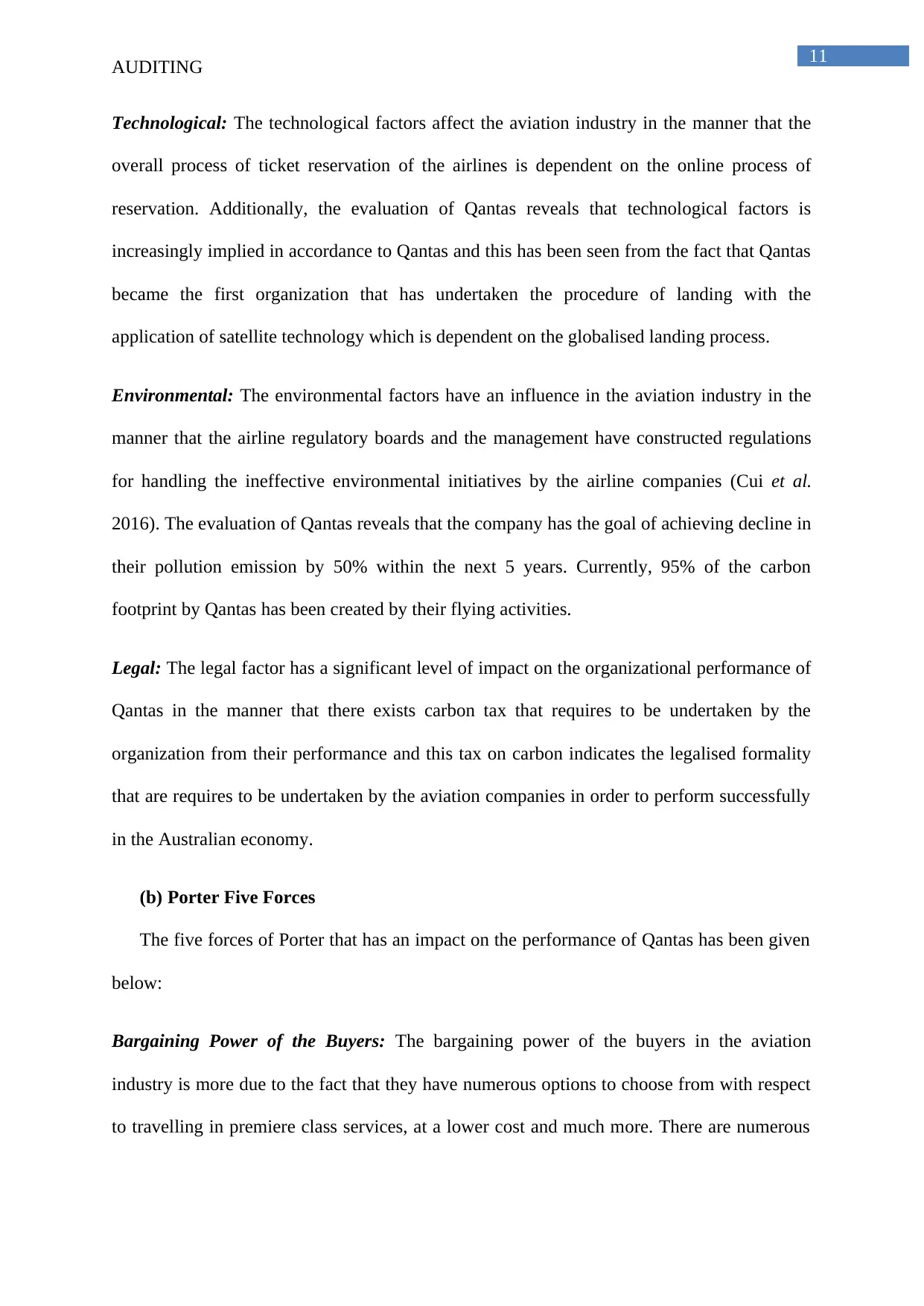
11
AUDITING
Technological: The technological factors affect the aviation industry in the manner that the
overall process of ticket reservation of the airlines is dependent on the online process of
reservation. Additionally, the evaluation of Qantas reveals that technological factors is
increasingly implied in accordance to Qantas and this has been seen from the fact that Qantas
became the first organization that has undertaken the procedure of landing with the
application of satellite technology which is dependent on the globalised landing process.
Environmental: The environmental factors have an influence in the aviation industry in the
manner that the airline regulatory boards and the management have constructed regulations
for handling the ineffective environmental initiatives by the airline companies (Cui et al.
2016). The evaluation of Qantas reveals that the company has the goal of achieving decline in
their pollution emission by 50% within the next 5 years. Currently, 95% of the carbon
footprint by Qantas has been created by their flying activities.
Legal: The legal factor has a significant level of impact on the organizational performance of
Qantas in the manner that there exists carbon tax that requires to be undertaken by the
organization from their performance and this tax on carbon indicates the legalised formality
that are requires to be undertaken by the aviation companies in order to perform successfully
in the Australian economy.
(b) Porter Five Forces
The five forces of Porter that has an impact on the performance of Qantas has been given
below:
Bargaining Power of the Buyers: The bargaining power of the buyers in the aviation
industry is more due to the fact that they have numerous options to choose from with respect
to travelling in premiere class services, at a lower cost and much more. There are numerous
AUDITING
Technological: The technological factors affect the aviation industry in the manner that the
overall process of ticket reservation of the airlines is dependent on the online process of
reservation. Additionally, the evaluation of Qantas reveals that technological factors is
increasingly implied in accordance to Qantas and this has been seen from the fact that Qantas
became the first organization that has undertaken the procedure of landing with the
application of satellite technology which is dependent on the globalised landing process.
Environmental: The environmental factors have an influence in the aviation industry in the
manner that the airline regulatory boards and the management have constructed regulations
for handling the ineffective environmental initiatives by the airline companies (Cui et al.
2016). The evaluation of Qantas reveals that the company has the goal of achieving decline in
their pollution emission by 50% within the next 5 years. Currently, 95% of the carbon
footprint by Qantas has been created by their flying activities.
Legal: The legal factor has a significant level of impact on the organizational performance of
Qantas in the manner that there exists carbon tax that requires to be undertaken by the
organization from their performance and this tax on carbon indicates the legalised formality
that are requires to be undertaken by the aviation companies in order to perform successfully
in the Australian economy.
(b) Porter Five Forces
The five forces of Porter that has an impact on the performance of Qantas has been given
below:
Bargaining Power of the Buyers: The bargaining power of the buyers in the aviation
industry is more due to the fact that they have numerous options to choose from with respect
to travelling in premiere class services, at a lower cost and much more. There are numerous
⊘ This is a preview!⊘
Do you want full access?
Subscribe today to unlock all pages.

Trusted by 1+ million students worldwide
1 out of 26
Related Documents
Your All-in-One AI-Powered Toolkit for Academic Success.
+13062052269
info@desklib.com
Available 24*7 on WhatsApp / Email
![[object Object]](/_next/static/media/star-bottom.7253800d.svg)
Unlock your academic potential
Copyright © 2020–2025 A2Z Services. All Rights Reserved. Developed and managed by ZUCOL.





